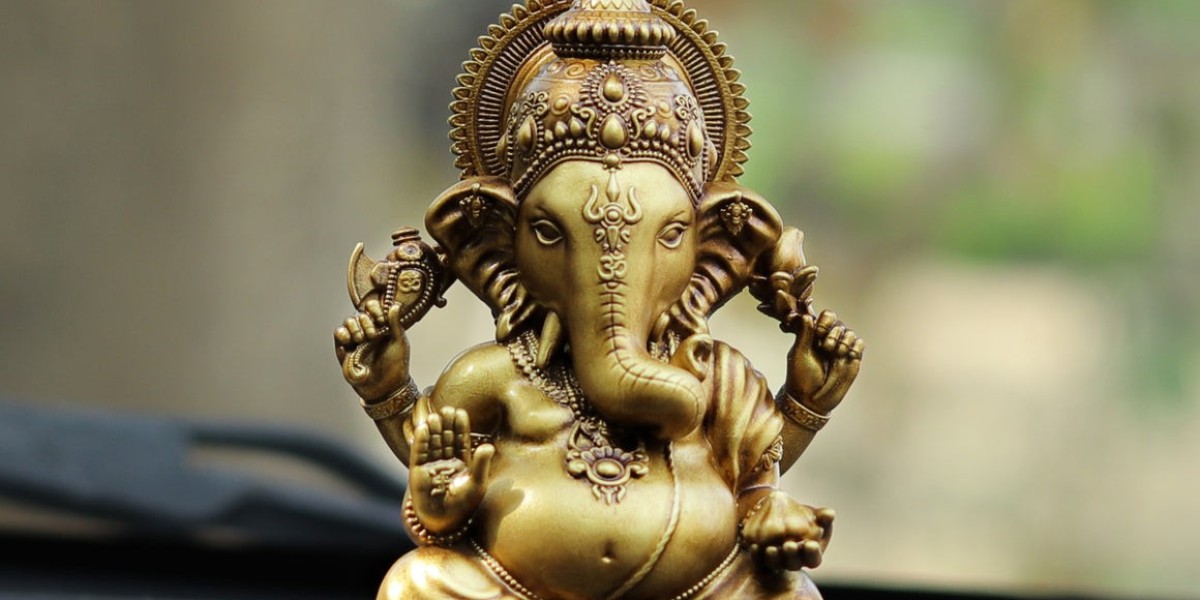Ganpati, also known as Lord Ganesha, is one of the most beloved deities in Hinduism. Revered as the remover of obstacles and the god of beginnings, wisdom, and prosperity, the Ganpati murti (idol) holds a special place in the hearts of devotees. Whether in homes, offices, or temples, a Ganpati murti is often the centerpiece of worship and celebration, especially during festivals like Ganesh Chaturthi. This blog delves into the significance, symbolism, and benefits of having a Ganpati murti, along with tips on its proper placement and worship.
The Significance of Lord Ganpati
Lord Ganpati is widely recognized by his distinctive elephant head, large ears, and a rotund belly, each of which carries deep symbolic meaning:
Elephant Head: The elephant head of Lord Ganpati symbolizes wisdom, intelligence, and a sharp mind. Elephants are also known for their memory, and Ganpati’s head represents the intellect that leads to success and prosperity.
Large Ears: The large ears of Ganpati signify that he is a good listener, ready to hear the prayers and concerns of his devotees. This also symbolizes the importance of listening more and speaking less, a key trait for gaining wisdom.
Trunk: Ganpati’s trunk is both flexible and strong, symbolizing adaptability and efficiency. The trunk’s ability to perform both delicate and mighty tasks reflects the idea that one should be versatile and effective in all aspects of life.
Broken Tusk: One of Ganpati’s tusks is broken, which is symbolic of the idea that sacrifices are sometimes necessary for achieving greater goals. It also represents the ability to overcome dualities like success and failure.
Large Belly: The large belly of Ganpati symbolizes the ability to peacefully digest all the good and bad in life. It represents abundance and the capacity to hold the universe within oneself, signifying prosperity and contentment.
Mouse as Vehicle (Vahana): The mouse, or Mushak, is the vehicle of Lord Ganpati, symbolizing that even the smallest creature can carry the weight of the god. It represents the idea that humility and small efforts can lead to great achievements.
The Spiritual and Practical Benefits of Ganpati Murti
The Ganpati murti is much more than a decorative or religious item; it is a spiritual tool that brings numerous benefits to those who revere it. Here are some of the key advantages of having a Ganpati murti in your home or workspace:
Remover of Obstacles: Lord Ganpati is known as Vighnaharta, the remover of obstacles. Devotees often invoke his blessings before starting new ventures, whether it’s a business, marriage, or even an academic endeavor. The presence of a Ganpati murti is believed to clear the path of obstacles, ensuring smooth progress and success.
Bringer of Prosperity: Ganpati is associated with wealth and prosperity. Worshipping a Ganpati murti can attract positive energy, leading to financial growth and overall well-being. It is common to place a Ganpati murti in businesses or offices to invoke his blessings for financial success.
Symbol of Wisdom: As the god of wisdom and intellect, Ganpati is worshipped by students and scholars seeking knowledge and clarity of thought. The Ganpati murti serves as a reminder of the importance of wisdom and learning in achieving life’s goals.
Harbinger of New Beginnings: Ganpati is the god of beginnings, and his murti is often worshipped at the start of new phases in life. Whether it’s a new home, a new business, or the beginning of a journey, invoking Ganpati’s blessings ensures a favorable start.
Protection from Negative Energies: The Ganpati murti is also believed to protect against negative energies and evil forces. Placing the murti in the home or office creates a protective aura, ensuring peace and harmony.
Choosing the Right Ganpati Murti
Selecting a Ganpati murti involves more than just aesthetic preferences; it’s about choosing a form that resonates with your spiritual needs and home environment. Here are some considerations:
Material: Ganpati murtis are made from various materials, including clay, metal, wood, and marble. Clay murtis are traditionally used during Ganesh Chaturthi for immersion, while metal or marble murtis are preferred for permanent installation. Each material has its own spiritual significance, with clay representing the earth and eco-friendliness, and metal or marble symbolizing strength and permanence.
Size: The size of the murti should be proportionate to the space where it will be placed. A large murti can be overwhelming in a small room, while a small murti may not have the desired impact in a large hall. The key is to ensure that the murti is easily visible and accessible for daily worship.
Pose: Ganpati murtis come in various poses, each with its own symbolism. The most common poses include sitting (which symbolizes calmness and stability), standing (indicating readiness for action), and dancing (representing joy and energy). Choose a pose that aligns with your intentions and the energy you want to invite into your space.
Color: The color of the Ganpati murti can also have symbolic meanings. For instance, red is associated with power and energy, while white represents peace and purity. Gold or yellow murtis are linked with prosperity and success. The color you choose should resonate with the energy you wish to cultivate.
Proper Placement and Worship of Ganpati Murti
The placement of the Ganpati murti in your home or workspace is crucial for maximizing its benefits. Here are some tips:
Placement Direction: The northeast corner of your home, known as the Ishan corner, is considered the most auspicious for placing the Ganpati murti. This direction is associated with prosperity and divine energy. Alternatively, the west, east, or north directions are also suitable.
Height: The murti should be placed at a height where it is easy to see and worship. It should not be placed directly on the floor; instead, use a raised platform or altar.
Daily Worship: Regular worship of the Ganpati murti is essential to maintain its divine energy. This can include offering flowers, lighting lamps, and chanting Ganpati mantras. Daily offerings of fresh fruits, sweets, and other items are also recommended.
Cleanliness: The area around the Ganpati murti should always be kept clean and free from clutter. This helps maintain the sanctity and purity of the space.
Special Occasions: During special occasions like Ganesh Chaturthi, additional rituals and decorations can be done to honor the Ganpati murti. This includes creating an elaborate altar, performing aarti (prayer rituals), and offering special prasad (sacred food).
Conclusion
The Ganpati murti is more than just an idol; it is a powerful symbol of wisdom, prosperity, and protection. By bringing a Ganpati murti into your home or workspace, you invite the divine presence of Lord Ganesha into your life, ensuring his blessings for success, happiness, and spiritual growth. Whether you are seeking to overcome obstacles, embark on new beginnings, or simply bring peace and prosperity into your surroundings, the Ganpati murti is a timeless representation of the divine energy that guides and protects us all.






